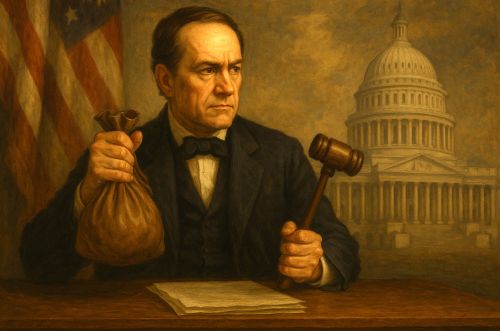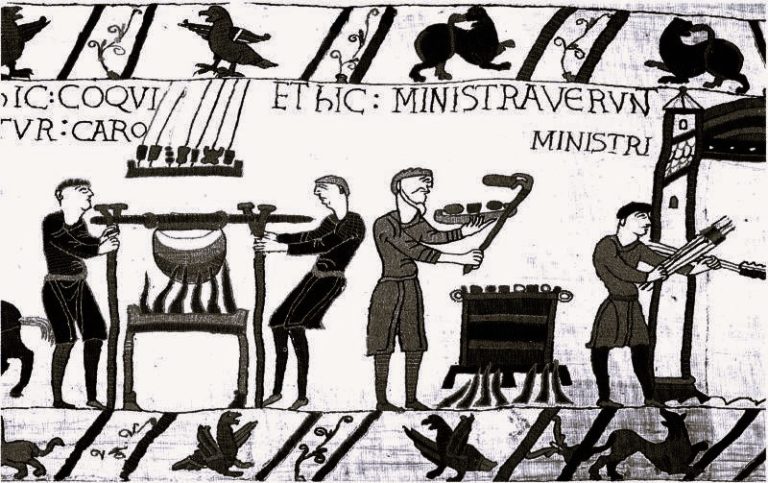

Across more than two centuries of American history, the struggle over the power of the purse has defined the balance between executive ambition and legislative authority.

By Matthew A. McIntosh
Public Historian
Brewminate
Introduction – The Purse as a Constitutional Principle
The “power of the purse” stands as one of the most vital mechanisms in the American constitutional framework, embodying the principle that control over public funds belongs not to a monarch or a president, but to the representatives of the people. From its inception, the United States was designed to prevent the consolidation of fiscal authority within a single branch of government. The Founders, having studied the abuses of royal prerogative in England, deliberately vested the power of appropriation in Congress as a safeguard against executive overreach. Article I, Section 9 of the Constitution therefore declares with clarity: “No Money shall be drawn from the Treasury, but in Consequence of Appropriations made by Law.”1
The lineage of this principle stretches back to the English Bill of Rights of 1689, which denied the Crown the ability to levy taxes or expend funds without Parliament’s consent.2 The American revolutionaries saw in that precedent both a warning and a model. James Madison, writing in Federalist No. 58, called the control of the purse “the most complete and effectual weapon” in the hands of the people’s representatives.3 To him and his contemporaries, fiscal control was not a procedural matter but a moral one, the ultimate means by which a free people could limit the temptations of executive ambition.
From the first Congress onward, that vision was rigorously maintained. Presidents from George Washington to Abraham Lincoln recognized that public money could be spent only with legislative consent, even during crises that tempted unilateral action. The recurring struggle between the executive’s need for flexibility and the legislature’s duty of oversight defined much of the nation’s political evolution. Over two centuries, Congress has repeatedly resisted efforts by presidents to circumvent appropriations, from Andrew Jackson’s removal of federal deposits during the “Bank War” to Franklin Roosevelt’s wartime expansions of budgetary discretion.
Yet the twenty-first century has witnessed a renewed challenge to that equilibrium. As the modern presidency has accumulated vast administrative and emergency powers, the boundaries of fiscal authority have blurred. Disputes over executive impoundment, reprogramming of funds, and emergency declarations have brought Congress’s constitutional role back to the forefront of public debate. In recent years, that contest has intensified under President Donald Trump, whose second term beginning in January 2025 has revived the question of whether a determined executive can effectively reclaim the power of the purse from the legislature.
The endurance of this principle (tested, strained, and reaffirmed) reveals more than a technical division of powers. It marks the line between republican governance and autocratic drift. The purse remains the people’s instrument, and in guarding it, Congress defends not merely its prerogatives but the very architecture of constitutional democracy.
The Founding Era – Legislative Supremacy Established

From the very beginning of the Republic, the architects of the Constitution treated Congress’s control over spending not as an ancillary feature but as the cornerstone of self-government. The framers, wary of the arbitrary fiscal powers once wielded by English kings, intentionally fragmented authority so that no single branch could command the treasury. As Alexander Hamilton observed in The Federalist No. 78, “the legislature not only commands the purse but prescribes the rules by which the duties and rights of every citizen are to be regulated.”4 To Hamilton, this separation ensured that even the strongest executive could act only “in subordination to the laws.”
During the First Congress (1789–1791), these ideals were tested in practice. Appropriations were debated line by line, each expenditure requiring explicit authorization.5 The Treasury Department, though newly created under Hamilton, operated entirely under congressional statutes. Washington himself, despite his broad prestige, deferred to legislative control of revenue and expenditure. When the issue of assuming state debts emerged as part of Hamilton’s financial plan, Washington insisted that congressional approval, not presidential preference, must determine the outcome.6 This precedent established an enduring understanding: even when executive leadership shaped fiscal policy, the power to allocate funds rested solely with Congress.
This legislative supremacy became both functional and symbolic. Functionally, it provided the mechanism by which the House of Representatives, the chamber “closest to the people,” could check the executive through appropriations bills. Symbolically, it expressed the core republican belief that taxation and spending derive legitimacy only from popular consent.7 Madison had articulated this logic in the Constitutional Convention, arguing that giving the purse to Congress was essential to prevent “the purse and the sword” from falling into the same hands.8
Still, the framers recognized that the line between fiscal oversight and executive implementation would always be a site of tension. Hamilton’s later Report on Manufactures (1791) envisioned federal subsidies and incentives that some legislators regarded as encroachments upon congressional discretion.9 Yet rather than displacing the legislature, Hamilton’s proposals affirmed the very structure the Constitution intended—one in which robust debate over money and purpose defined the boundaries of governmental power.
By the end of the eighteenth century, the new Republic had already institutionalized this contest as a constitutional ritual. Every appropriation, every tax, every debt assumption required not only agreement but vigilance. The Founders had converted financial control into the practical expression of liberty itself: by binding the executive to Congress through the purse, they ensured that government remained accountable to the governed.
Nineteenth-Century Conflicts – The Purse and the Presidency

The nineteenth century transformed the relationship between Congress and the presidency into a continuous struggle over fiscal control. What the framers conceived as legislative supremacy faced repeated tests as presidents confronted economic crises, wars, and ideological battles over the scope of federal authority. Yet, even amid sweeping political realignments, Congress repeatedly reaffirmed its dominion over the purse, forcing presidents to defend their actions within constitutional limits.
Andrew Jackson’s presidency provided the first major rupture. His confrontation with the Second Bank of the United States in the 1830s exposed deep tensions between populist executive energy and congressional oversight. Jackson’s decision to remove federal deposits from the Bank, despite the Senate’s opposition and without explicit legislative authorization, sparked a constitutional crisis. Henry Clay and his allies denounced the move as an assertion of “monarchical prerogative,” while Jackson framed it as a democratic defense of the people’s funds.10 In response, Congress censured the president in 1834, marking one of the earliest legislative rebukes of executive fiscal action.11 Though the censure was later expunged, the episode underscored a principle that would echo throughout American history: when presidents act unilaterally with public money, Congress alone can restore balance.
The Civil War renewed those tensions under far graver circumstances. Abraham Lincoln, facing rebellion and the collapse of federal revenues, authorized expenditures and troop mobilizations before Congress reconvened in July 1861.12 While his actions were later ratified by statute, Lincoln himself acknowledged that he had operated on necessity, not right, and sought congressional approval retroactively.13 This sequence, executive initiative followed by legislative ratification, would become a recurring pattern during national emergencies, revealing both the flexibility and the fragility of the constitutional order.
After the war, the conflict reversed direction. A radical Republican Congress, wary of presidential leniency toward the defeated South, moved to constrain the executive through appropriations and statutory restrictions. The Tenure of Office Act of 1867 and related riders in funding bills curtailed Andrew Johnson’s ability to dismiss officials and direct spending.14 When Johnson defied these provisions, the House impeached him, invoking not only political disobedience but a violation of the fiscal subordination expected of the presidency.15 The impeachment trial, though ending in acquittal by a single vote, cemented the postwar belief that the executive could not unilaterally appropriate or withhold funds without legislative sanction.
By century’s end, Congress had weathered multiple challenges yet emerged with its purse power intact. Appropriations bills became the primary instruments of national policy, used not merely to fund government but to direct its priorities. In this balance, presidents learned that their power to act depended ultimately upon Congress’s power to pay, a lesson repeatedly taught, resisted, and reaffirmed in every subsequent era.
Twentieth-Century Expansion – The New Deal and Beyond

The twentieth century marked a profound transformation in the federal government’s fiscal architecture. Economic depression, global war, and the rise of the administrative state expanded the scope of executive power in ways unimaginable to the framers. Yet, even amid this growth, Congress persistently sought to reaffirm its control over appropriations, reasserting the purse as the boundary of legitimate presidential authority.
The Great Depression tested this equilibrium more severely than any previous crisis. Franklin D. Roosevelt’s New Deal programs demanded unprecedented federal spending and the rapid creation of new agencies. Congress initially granted wide discretion through broad authorizing statutes such as the National Industrial Recovery Act of 1933, which allowed the executive to allocate funds and set economic codes.16 While these measures stabilized parts of the economy, they also blurred the constitutional distinction between appropriations and implementation. Critics, including members of Congress, warned that the legislature had ceded too much of its traditional authority.17 The Supreme Court soon agreed: in Schechter Poultry Corp. v. United States (1935), it struck down the NIRA as an unconstitutional delegation of legislative power, reinforcing that Congress could not surrender its control of spending and regulation without violating the separation of powers.18
World War II intensified executive dominance but also laid the groundwork for institutional reform. The enormous scale of wartime mobilization required Congress to authorize vast sums under emergency powers, yet lawmakers remained intent on preserving oversight.19 After the war, the Budget and Accounting Act of 1921, originally passed to improve coordination between the president and Congress, had already centralized budget preparation in the White House but simultaneously created the General Accounting Office (now the Government Accountability Office) to report directly to Congress.20 This dual structure institutionalized the tension between efficiency and accountability that defines the budget process to this day.
By the 1970s, the pendulum swung decisively back toward Congress. Following the Watergate scandal and President Richard Nixon’s impoundment of congressionally appropriated funds, lawmakers passed the Congressional Budget and Impoundment Control Act of 1974.21 The statute prohibited presidents from withholding funds without explicit congressional approval and established the Congressional Budget Office to provide independent fiscal analysis.22 These reforms reasserted legislative control and laid the groundwork for future judicial rulings that reaffirmed the same principle. In Train v. City of New York (1975), the Supreme Court held that Nixon’s refusal to spend allocated funds violated the law, declaring that the executive must “faithfully execute” enacted appropriations.23 Later, in Clinton v. City of New York (1998), the Court struck down the line-item veto as unconstitutional, confirming that only Congress possesses the power to alter or rescind appropriations once enacted.24
The twentieth century thus concluded where it began, with Congress reminding the presidency that efficiency is not sovereignty. The power of the purse, though often obscured by administrative complexity, remained the fundamental instrument by which the legislature shaped the nation’s priorities. Presidents might propose, interpret, or even resist, but only Congress could pay.
Contemporary Challenges – Executive Power in the Modern Era

The dawn of the twenty-first century renewed old battles over fiscal authority under new conditions of global conflict, economic crisis, and political polarization. Each presidency since 2001 has tested the constitutional limits of the purse in different ways, revealing both the resilience and vulnerability of Congress’s control over spending.
After the September 11 attacks, President George W. Bush oversaw a dramatic expansion of executive power under the banner of national security. Congress appropriated trillions through emergency supplemental bills for military operations in Afghanistan and Iraq, often with minimal oversight.25 The reliance on supplemental appropriations, outside the normal budgetary process, allowed the executive to shape priorities and expenditures with relative autonomy. Critics, including members of the Government Accountability Office, warned that this bypassed long-standing fiscal safeguards.26 Yet Congress’s initial deference reflected a familiar wartime paradox: in moments of crisis, legislative restraint yields to the perceived necessity of executive speed.
The pendulum swung again under President Barack Obama. Facing congressional gridlock after 2010, the administration relied heavily on executive actions and reprogramming within existing appropriations.27 While many of these measures, such as the Deferred Action for Childhood Arrivals (DACA) program, did not directly appropriate new funds, they nonetheless redefined how existing ones could be used. Congress, divided and often paralyzed, struggled to respond coherently.28 The tension revealed a new dynamic, where executive initiative thrived not from overt defiance of Congress but from its inaction.
Donald Trump’s first term reignited explicit constitutional confrontation. In 2019, after Congress refused to fund his proposed border wall beyond limited allocations, the president declared a national emergency and redirected roughly $3.6 billion in military construction funds.29 Multiple federal courts ruled the diversion unconstitutional, citing Article I’s Appropriations Clause and reaffirming that the president cannot “spend funds that Congress has refused to authorize.”30 Even so, the episode underscored how emergency statutes and flexible budgetary categories had given modern presidents tools to test the limits of legislative control.
This cycle of assertion and resistance exposed the fragility of Congress’s financial prerogatives. The very complexity of the federal budget (its reliance on continuing resolutions, omnibus bills, and executive implementation) invited encroachment by presidents of both parties. By the early 2020s, scholars and policymakers alike were warning that the accumulation of executive discretion risked hollowing out the core principle Madison once called the “most complete and effectual weapon” of popular government.31
The stage was thus set for the most aggressive test yet in Trump’s second term, which began in January 2025, a renewed campaign to reclaim executive command over spending that Congress had already appropriated.32 The consequences of that effort, and Congress’s response, would determine whether the American Republic still holds fast to the balance envisioned at its birth.
Trump’s Second Term (2025–Present) – A Renewed Assault on the Purse
President Donald Trump’s second term, beginning in January 2025, has reopened one of the oldest constitutional conflicts in American history. Reviving strategies from his first administration and introducing new ones, Trump has sought to reclaim executive discretion over congressionally appropriated funds, an effort that has drawn sharp resistance from both parties in Congress and renewed litigation over the boundaries of fiscal power.
Central to this conflict is the president’s revival of impoundment, the withholding or delay of funds already approved by Congress. In early 2025, investigative reports revealed that the administration had frozen billions in spending across multiple departments, from foreign aid to environmental programs, often without timely notice to lawmakers.33 According to analyses compiled by ProPublica and PBS NewsHour, more than $425 billion in appropriated funds were delayed, rescinded, or subjected to “pocket impoundments” in the first months of Trump’s new term.34 Administration officials defended the tactic as a means of controlling “wasteful” spending and “restoring presidential budget authority.”35
Congress responded forcefully. Bipartisan members of the House and Senate Budget Committees accused the White House of violating the Impoundment Control Act of 1974, which requires presidents to obtain congressional approval for any rescission or deferral of appropriated funds.36 A joint statement from the Senate Appropriations Committee warned that the executive branch “cannot substitute its political preferences for duly enacted law.”37 Several lawsuits soon followed, with plaintiffs arguing that the administration’s withholding of funds, especially in foreign aid, amounted to an unconstitutional seizure of legislative power.38
The dispute echoes earlier confrontations between the branches but with sharper implications. Unlike Nixon’s impoundments of the early 1970s, Trump’s current actions unfold amid a fractured political environment and a judiciary reshaped by his appointments.39 While some lower courts have issued injunctions compelling agencies to release withheld funds, others have deferred to executive discretion under statutory ambiguity, leaving the final outcome uncertain.40 The controversy has thus become not only a test of institutional limits but also a measure of whether the rule of law can restrain a president openly hostile to congressional constraint.
In response, lawmakers have advanced new proposals to strengthen the Impoundment Control Act and close procedural loopholes that enable “pocket rescissions.”41 The House Budget Committee introduced the Protecting Congress’s Power of the Purse Act, which would eliminate expedited procedures for executive rescission requests and impose penalties for noncompliance.42 Though passage remains uncertain, the bill represents a renewed assertion of legislative authority at a moment when the balance of constitutional power hangs in the balance.
The broader implications of Trump’s second-term fiscal strategy reach far beyond partisan skirmishes. By withholding congressionally appropriated funds, the administration has revived a centuries-old question: whether the president is bound to execute the law or entitled to reinterpret it. In testing that boundary, Trump has forced Congress, and the courts, to confront once again the enduring truth that liberty depends upon who holds the purse.
Conclusion – The Purse as the Last Line of Constitutional Defense
Across more than two centuries of American history, the struggle over the power of the purse has defined the balance between executive ambition and legislative authority. From Madison’s insistence that control of money was the people’s “most effectual weapon,” to Congress’s continuing efforts to restrain modern presidents, this contest has never been resolved but only renewed. Each generation has discovered that liberty depends not on the goodwill of leaders but on the endurance of institutions strong enough to say no.
The historical record demonstrates that when Congress defends its fiscal authority, constitutional equilibrium is preserved. When it yields (whether through emergency delegations, political paralysis, or indifference) the presidency expands by default. As Louis Fisher observed, “the concentration of fiscal and administrative power in the executive is the surest route to autocracy.”43 That warning remains as relevant today as when it was first voiced during the Nixon era. Congress’s authority to appropriate is not simply procedural; it is moral and democratic, binding the will of elected representatives to the stewardship of the nation’s wealth.
The current confrontation under President Trump’s second term has made this truth impossible to ignore. His efforts to impound funds and reinterpret legislative authority have exposed both the vulnerability and resilience of the constitutional system. Courts have intervened unevenly, and Congress has responded with proposals to reinforce statutory safeguards. Whether these measures succeed will determine more than the outcome of a partisan dispute. They will decide whether the foundational promise of Article I, that no money may leave the Treasury without the people’s consent, still governs in practice as well as in principle.
The power of the purse remains the Republic’s final defense against tyranny. Its endurance affirms that government remains accountable to law rather than to personality, and that sovereignty belongs not to the occupant of the presidency but to the people whose representatives hold the key to the Treasury. To guard that key is to guard the Constitution itself.
Appendix
Footnotes
- U.S. Const. art. I, § 9, cl. 7.
- “English Bill of Rights (1689),” The Avalon Project, Yale Law School, accessed October 2025, https://avalon.law.yale.edu/17th_century/england.asp.
- James Madison, The Federalist No. 58, in The Federalist Papers, ed. Clinton Rossiter (New York: New American Library, 1961), 359.
- Alexander Hamilton, The Federalist No. 78, in The Federalist Papers, ed. Clinton Rossiter (New York: New American Library, 1961), 466.
- Joseph Postell, “Congressional Power and the Purse,” Heritage Foundation Backgrounder No. 3302 (2018), 4.
- Ron Chernow, Alexander Hamilton (New York: Penguin Press, 2004), 331–335.
- Jack N. Rakove, Original Meanings: Politics and Ideas in the Making of the Constitution (New York: Knopf, 1996), 291–293.
- James Madison, Notes of Debates in the Federal Convention of 1787, ed. Adrienne Koch (New York: Norton, 1987), 379.
- Alexander Hamilton, Report on Manufactures (December 5, 1791), in The Papers of Alexander Hamilton, vol. 10, ed. Harold C. Syrett (New York: Columbia University Press, 1966), 230–232.
- Robert V. Remini, Andrew Jackson and the Bank War (New York: W. W. Norton, 1967), 123–128.
- Daniel Walker Howe, What Hath God Wrought: The Transformation of America, 1815–1848 (New York: Oxford University Press, 2007), 389–391.
- James M. McPherson, Tried by War: Abraham Lincoln as Commander in Chief (New York: Penguin Press, 2008), 35–39.
- Abraham Lincoln, “Message to Congress in Special Session,” July 4, 1861, in Collected Works of Abraham Lincoln, vol. 4, ed. Roy P. Basler (New Brunswick: Rutgers University Press, 1953), 421–422.
- Eric Foner, Reconstruction: America’s Unfinished Revolution, 1863–1877 (New York: Harper & Row, 1988), 334–336.
- Michael Les Benedict, The Impeachment and Trial of Andrew Johnson (New York: W. W. Norton, 1999), 215–219.
- National Industrial Recovery Act of 1933, Pub. L. No. 73-67, 48 Stat. 195.
- Ira Katznelson, Fear Itself: The New Deal and the Origins of Our Time (New York: Liveright, 2013), 220–223.
- Schechter Poultry Corp. v. United States, 295 U.S. 495 (1935).
- John Morton Blum, V Was for Victory: Politics and American Culture During World War II (New York: Harcourt Brace Jovanovich, 1976), 27–29.
- Louis Fisher, Presidential Spending Power (Princeton: Princeton University Press, 1975), 44–48.
- Congressional Budget and Impoundment Control Act of 1974, Pub. L. No. 93-344, 88 Stat. 297.
- Allen Schick, The Federal Budget: Politics, Policy, Process, 3rd ed. (Washington, D.C.: Brookings Institution Press, 1995), 31–33.
- Train v. City of New York, 420 U.S. 35 (1975).
- Clinton v. City of New York, 524 U.S. 417 (1998).
- Amy Belasco, The Cost of Iraq, Afghanistan, and Other Global War on Terror Operations Since 9/11 (Washington, D.C.: Congressional Research Service, 2014), 1–4.
- U.S. Government Accountability Office, Global War on Terrorism: DOD Needs to Take Action to Encourage Fiscal Discipline and Optimize the Use of Tools Intended to Improve GWOT Cost Reporting (GAO-09-302, 2009), 5–6.
- Kenneth R. Mayer, With the Stroke of a Pen: Executive Orders and Presidential Power (Princeton: Princeton University Press, 2001), 212–214.
- Charles O. Jones, The Presidency in a Separated System (Washington, D.C.: Brookings Institution Press, 1994), 156–160.
- Department of Defense v. Sierra Club, 140 S. Ct. 1 (2019).
- U.S. House of Representatives v. Mnuchin, 976 F.3d 1 (D.C. Cir. 2020).
- James Madison, The Federalist No. 58, 359.
- “Trump Revives Impoundment Tactics to Block Congress-Approved Spending,” ProPublica, updated May 2025, https://www.propublica.org/article/trump-impoundment-appropriations-congress-budget.
- Justin Elliott, “Trump Impounds Billions in Spending Congress Approved,” ProPublica, March 2025, https://www.propublica.org/article/trump-impoundment-appropriations-congress-budget.
- Laura Barrón-López, “Trump’s Attempt to Claw Back Funding Approved by Congress Explained,” PBS NewsHour, June 24, 2025, https://www.pbs.org/newshour/show/trumps-attempt-to-claw-back-funding-approved-by-congress-explained.
- “White House Defends Spending Freezes as ‘Restoring Budget Discipline,’” Reuters, April 12, 2025, https://www.reuters.com.
- Congressional Budget and Impoundment Control Act of 1974, Pub. L. No. 93-344, 88 Stat. 297.
- Senate Appropriations Committee, Statement on Executive Impoundments, May 2025, https://www.appropriations.senate.gov.
- Brennan Center for Justice, “Lawsuits Reveal Administration’s Attacks on Congressional Power,” May 2025, https://www.brennancenter.org/our-work/analysis-opinion/lawsuits-reveal-administrations-attacks-congressional-power.
- Peter Baker, “Trump Tests Legal Boundaries Again With Fiscal Power Play,” The New York Times, May 20, 2025, https://www.nytimes.com.
- Center for Biological Diversity v. Office of Management and Budget, 2025 WL 1832094 (D.D.C. May 2025).
- House Committee on the Budget, Fact Sheet: Protecting Congress’s Power of the Purse, June 2025, https://democrats-budget.house.gov/resources/fact-sheet/protecting-congress-power-purse.
- Protecting Congress’s Power of the Purse Act, H.R. 4217, 119th Cong. (2025).
- Louis Fisher, Constitutional Conflicts Between Congress and the President, 6th ed. (Lawrence: University Press of Kansas, 1985), 329.
Bibliography
- Avalon Project. “English Bill of Rights (1689).” Yale Law School. Accessed October 2025. https://avalon.law.yale.edu/17th_century/england.asp.
- Baker, Peter. “Trump Tests Legal Boundaries Again With Fiscal Power Play.” The New York Times, May 20, 2025. https://www.nytimes.com.
- Barrón-López, Laura. “Trump’s Attempt to Claw Back Funding Approved by Congress Explained.” PBS NewsHour, June 24, 2025. https://www.pbs.org/newshour/show/trumps-attempt-to-claw-back-funding-approved-by-congress-explained.
- Basler, Roy P., ed. Collected Works of Abraham Lincoln. Vol. 4. New Brunswick: Rutgers University Press, 1953.
- Belasco, Amy. The Cost of Iraq, Afghanistan, and Other Global War on Terror Operations Since 9/11. Washington, D.C.: Congressional Research Service, 2014.
- Benedict, Michael Les. The Impeachment and Trial of Andrew Johnson. New York: W. W. Norton, 1999.
- Blum, John Morton. V Was for Victory: Politics and American Culture During World War II. New York: Harcourt Brace Jovanovich, 1976.
- Brennan Center for Justice. “Lawsuits Reveal Administration’s Attacks on Congressional Power.” May 2025. https://www.brennancenter.org/our-work/analysis-opinion/lawsuits-reveal-administrations-attacks-congressional-power.
- Chernow, Ron. Alexander Hamilton. New York: Penguin Press, 2004.
- Congressional Budget and Impoundment Control Act of 1974, Pub. L. No. 93-344, 88 Stat. 297.
- Department of Defense v. Sierra Club, 140 S. Ct. 1 (2019).
- Elliott, Justin. “Trump Impounds Billions in Spending Congress Approved.” ProPublica, March 2025. https://www.propublica.org/article/trump-impoundment-appropriations-congress-budget.
- Fisher, Louis. Constitutional Conflicts Between Congress and the President. 6th ed. Lawrence: University Press of Kansas, 1985.
- ———. Presidential Spending Power. Princeton: Princeton University Press, 1975.
- Foner, Eric. Reconstruction: America’s Unfinished Revolution, 1863–1877. New York: Harper & Row, 1988.
- Hamilton, Alexander. The Federalist No. 78. In The Federalist Papers, edited by Clinton Rossiter. New York: New American Library, 1961.
- ———. Report on Manufactures (December 5, 1791). In The Papers of Alexander Hamilton. Vol. 10, edited by Harold C. Syrett. New York: Columbia University Press, 1966.
- House Committee on the Budget. Fact Sheet: Protecting Congress’s Power of the Purse. June 2025. https://democrats-budget.house.gov/resources/fact-sheet/protecting-congress-power-purse.
- Howe, Daniel Walker. What Hath God Wrought: The Transformation of America, 1815–1848. New York: Oxford University Press, 2007.
- Jones, Charles O. The Presidency in a Separated System. Washington, D.C.: Brookings Institution Press, 1994.
- Katznelson, Ira. Fear Itself: The New Deal and the Origins of Our Time. New York: Liveright, 2013.
- Madison, James. Notes of Debates in the Federal Convention of 1787. Edited by Adrienne Koch. New York: Norton, 1987.
- ———. The Federalist No. 58. In The Federalist Papers, edited by Clinton Rossiter. New York: New American Library, 1961.
- Mayer, Kenneth R. With the Stroke of a Pen: Executive Orders and Presidential Power. Princeton: Princeton University Press, 2001.
- McPherson, James M. Tried by War: Abraham Lincoln as Commander in Chief. New York: Penguin Press, 2008.
- National Industrial Recovery Act of 1933, Pub. L. No. 73-67, 48 Stat. 195.
- Protecting Congress’s Power of the Purse Act, H.R. 4217, 119th Cong. (2025).
- Rakove, Jack N. Original Meanings: Politics and Ideas in the Making of the Constitution. New York: Knopf, 1996.
- Remini, Robert V. Andrew Jackson and the Bank War. New York: W. W. Norton, 1967.
- Reuters. “White House Defends Spending Freezes as ‘Restoring Budget Discipline.’” April 12, 2025. https://www.reuters.com.
- Schick, Allen. The Federal Budget: Politics, Policy, Process. 3rd ed. Washington, D.C.: Brookings Institution Press, 1995.
- Schechter Poultry Corp. v. United States, 295 U.S. 495 (1935).
- Senate Appropriations Committee. Statement on Executive Impoundments. May 2025. https://www.appropriations.senate.gov.
- Train v. City of New York, 420 U.S. 35 (1975).
- Clinton v. City of New York, 524 U.S. 417 (1998).
- Trump Revives Impoundment Tactics to Block Congress-Approved Spending. ProPublica. Updated May 2025. https://www.propublica.org/article/trump-impoundment-appropriations-congress-budget.
- U.S. Constitution, Article I, Section 9, Clause 7.
- U.S. Government Accountability Office. Global War on Terrorism: DOD Needs to Take Action to Encourage Fiscal Discipline and Optimize the Use of Tools Intended to Improve GWOT Cost Reporting. GAO-09-302. Washington, D.C.: Government Accountability Office, 2009.
- U.S. House of Representatives v. Mnuchin, 976 F.3d 1 (D.C. Cir. 2020).
- Center for Biological Diversity v. Office of Management and Budget, 2025 WL 1832094 (D.D.C. May 2025).
Originally published by Brewminate, 10.13.2025, under the terms of a Creative Commons Attribution-NonCommercial-NoDerivatives 4.0 International license.


